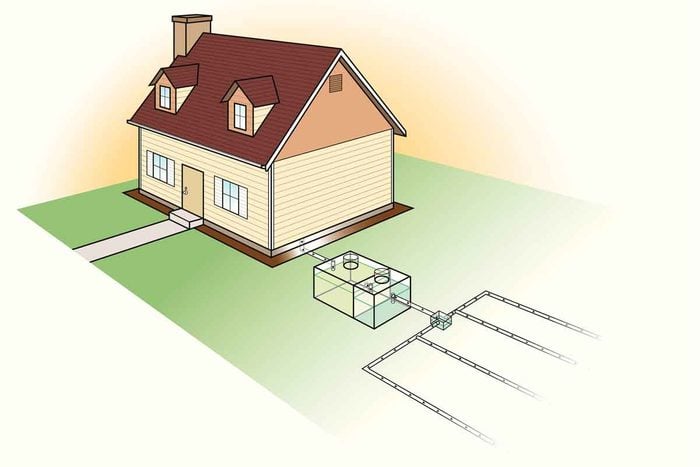What You Need to Know About Your Septic System’s Drainfield
Updated: Mar. 07, 2024

Knowing how to care for and maintain your drainfield will keep your entire septic system running properly.
If you’re not hooked up to a municipal sewer system, chances are you’re using a septic system for all of your wastewater. When you flush the toilet, or water runs down the drain from sinks or the laundry, it flows into your septic tank. There are various types of residential septic systems, but generally all consist of a septic tank, where wastewater flows for treatment, and the drainfield, where wastewater evaporates or drains into the soil.
On This Page
What Is a Septic System Drainfield?
Septic system drainfields, also called leach fields or absorption fields, are critical to a properly functioning septic system because they remove and manage the wastewater pumped from the septic tank. They feature perforated pipes buried two to four feet underground running from the tank. Without a drainfield, septic tanks would overflow, creating runoff and a bad odor in your yard.
When everything is working well, the soil in the drainfield filters the wastewater, and natural bacteria and microbes break down the waste. Drainfields, like any other part of your septic system, require care and maintenance. Are you familiar with the concept of grey water systems? These simple systems take unfiltered grey water and distribute it to larger plants, like trees and bushes.
What Are the Signs There Is a Problem With Your Drainfield?
- Sewage odors, specifically outside near the septic tank and drainfield.
- Presence of dark green, lush vegetation over the drainfield. It may look nice, but it points to an overstressed septic system.
- Wet, soggy or spongy areas over the septic tank or drainfield, even during dry weather. You may even notice pools of standing water.
- Slow kitchen and bathroom drains.
- Overflowing toilets or sewage backups.
What Are the Causes of These Problems?
The age of the drainfield
With good care and maintenance, a drainfield will last for 50 years or more. But many of the signs noted above could signal an aging drainfield. The system simply has no more capacity to accept waste. This can cause sewage backups, a foul smell outside and slow drainage in your home.
Crushing damage
When placed over the drainfield, weighty items such as a shed, animals or vehicles can crush the pipes below. Excessive weight on the drainfield can also cause the soil to compact. Wastewater can’t be properly absorbed in compacted soil, triggering many of the signs noted above.
Pipes are blocked
Tree and plant roots may have infiltrated the pipes, preventing the wastewater from draining properly. Sludge buildup and items that shouldn’t be flushed down the toilet may also clog pipes.
The septic system is overloaded
Doing several loads of laundry while running the dishwasher on the same day can overload the septic system. So can a dripping faucet or a running toilet.
All septic systems need time to allow the wastewater to go through the treatment procedure. Otherwise, the wastewater is forced to flow into the drainfield at a faster rate than the drainfield can handle. This can lead to standing water or those soggy, spongy areas mentioned above.
Gutter downspouts draining over the drainfield
Gutters that drain out over the septic system drainfield make it harder for the drainfield to absorb wastewater. This could lead to a continuous soggy area or standing water.
What to Do to Maintain a Healthy Drainfield
- Keep the area above your drainfield free of heavy equipment, autos, RVs, boats, grazing animals and outbuildings.
- Do not plant trees or vegetation over your drainfield; the roots can damage the pipes.
- Make sure all gutter downspouts drain away from the drainfield.
- Pump your septic tank every two to three years. Lack of periodic pumping causes solids to be carried into the drainfield, clogging the pipes.
- The only thing that should be flushed down the toilet, aside from what comes out of your body, is toilet paper. Do not flush any other solids. And avoid pouring any fats, oil or grease down your drains.
- Spread out your laundry and dishwashing days so you don’t overload the septic system.
